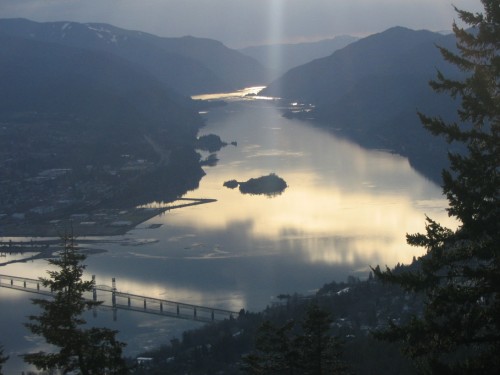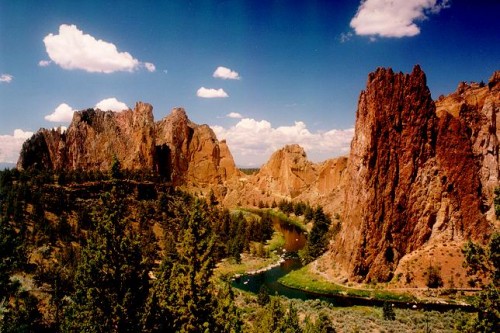 It seems like over the last 10 years or so, I've read roughly eleventy-bajillion trend pieces about the confluence of environmentalism and religion. Most of these pieces have been fairly uncritical about or even cheerleading this commingling. So I wasn't terribly enthused to see this New York Times story, "Pastors in Northwest Find Focus in 'Green.'"
Now I'm from the Northwest. My mother grew up in Portland and when I was very young we spent six years living in a tiny town in Southern Washington on a hill above the Columbia River Gorge. The view from my front yard was such that a National Geographic photographer knocked on our door one day asked if he could take pictures from our deck. (The picture you're looking at to the left is a rough approximation of what it's like to look west from a hill above White Salmon, Washington. And here's a slightly more up close picture of what you saw when you looked out my living room window, just above sea level to the summit of Mt. Hood at 11,000 feet about 50 miles due south -- yeah, I know.) Then we moved to Bend, Oregon, which is about as close to an environmental paradise as exists in this country. (The photo below is of Smith Rock State Park where I took Mollie and Evangeline hiking last time we were visiting my folks.)
It seems like over the last 10 years or so, I've read roughly eleventy-bajillion trend pieces about the confluence of environmentalism and religion. Most of these pieces have been fairly uncritical about or even cheerleading this commingling. So I wasn't terribly enthused to see this New York Times story, "Pastors in Northwest Find Focus in 'Green.'"
Now I'm from the Northwest. My mother grew up in Portland and when I was very young we spent six years living in a tiny town in Southern Washington on a hill above the Columbia River Gorge. The view from my front yard was such that a National Geographic photographer knocked on our door one day asked if he could take pictures from our deck. (The picture you're looking at to the left is a rough approximation of what it's like to look west from a hill above White Salmon, Washington. And here's a slightly more up close picture of what you saw when you looked out my living room window, just above sea level to the summit of Mt. Hood at 11,000 feet about 50 miles due south -- yeah, I know.) Then we moved to Bend, Oregon, which is about as close to an environmental paradise as exists in this country. (The photo below is of Smith Rock State Park where I took Mollie and Evangeline hiking last time we were visiting my folks.)
My immediate reaction is that this would probably cover some cultural ground I'm pretty familiar with -- thus making any errors or dubious characterizations particularly obvious. Everybody in the Pacific Northwest -- particularly those that have been there for multiple generations -- has strong opinions about the environment and the rapid population growth in the last few decades. The influx of new people has brought about pretty dramatic changes in the religious and political character or Oregon and Washington .
So I went into the story loaded for bear. And you know what? It's not that bad. It discusses the environmentalism-in-religion trend in a pretty clear-eyed fashion. For one, it posits that churches embracing environmentalism are becoming more focused on local issues than global warming:
Religious leaders have been preaching environmentalism for years, and much attention has focused on politically powerful evangelical Christian leaders who have taken up climate change as a cause. Yet some smaller, older and often struggling mainline churches are also going greener, reducing their carbon footprint by upgrading basement boilers and streamlining the Sunday bulletin, swapping Styrofoam for ceramic mugs at coffee hour and tending jumbled vegetable gardens where lawns once were carefully cultivated.
The story provides some good local color to that extent, but I wish there was a better way to know how widespread this trend away from overarching issues and toward local action is.
Still, this is an interesting development. As you might expect, it notes that people are hopeful about the potential of environmentalism as an evangelical tool:
Several mainline church leaders in the Northwest said environmentalism offered an entry point, especially to younger adults, who might view Christianity as wrought with debates over gay rights and abortion.
A study released in December by the Barna Group, which more typically studies trends among evangelicals, said that older, mainline churches faced many challenges but that their approach to environmental issues was among several areas that "position those churches well for attracting younger Americans."
"We actually encourage it as a way to get people into the churches," said LeeAnne Beres, the executive director of Earth Ministry, a Seattle group founded in 1992 that has guided many area congregations through environmental upgrades over the past decade but has recently emphasized more direct political action for pastors and parishioners. "That is what people are interested in, and I don't see anything Machiavellian in that."
 However, the story doesn't provide any of evidence environmentalism has had much of an effect on the abysmal church attendance in the Pacific Northwest. And the anecdotal evidence in the story suggests the opposite:
However, the story doesn't provide any of evidence environmentalism has had much of an effect on the abysmal church attendance in the Pacific Northwest. And the anecdotal evidence in the story suggests the opposite:
He noted that while some mainline churches had reported increased attendance as they emphasized the issue, Emmanuel's congregation, now about 250 families, had declined even though the church had been active on environmental issues for more than a decade.
And:
At Westminster Congregational United Church of Christ near downtown Spokane, built in 1893, the congregation has about 200 people, down from 2,000 a few decades ago. The pastor, Andrea CastroLang, said the church recently had an energy audit and that while it has made some of the proposed changes, including upgrading the boiler, some were impractical for the soaring, heat-leaking sanctuary.
"They were like, 'It'd be really great if you could lower your ceiling,'" Ms. CastroLang said. "We said, 'We can't do that.'"
That last bit about lowering the ceiling is chuckle-worthy.
Still, I wish there was more concrete information on how this trend has affected attendance. However, as a reporter I sympathize with how difficult it is to suss out data on these kind of social trend stories. All in all, a more interesting and nuanced take on what seems like an, uh, evergreen topic on the Godbeat these days.
